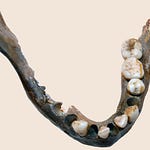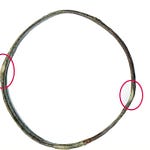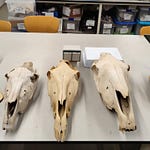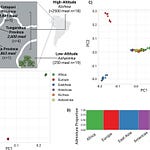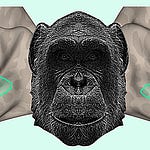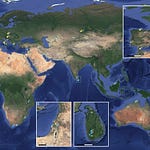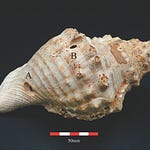In a dusty alley of an ancient city once known as Gath, four donkeys were buried beneath the floors of modest homes. Their heads were turned to the east, their legs bound tightly beneath their abdomens. These were not the casualties of illness or accidents. They were sacrificed.
New research published in PLOS ONE1 by Elizabeth Arnold and colleagues has provided rare isotopic evidence that these donkeys were not local animals at all. Born and raised along the Nile Valley, they were transported hundreds of kilometers before meeting their end beneath the feet of a growing Canaanite town. That town, Tell eṣ-Ṣâfi/Gath, located in what is now central Israel, was becoming one of the largest urban centers in the southern Levant around 2900 to 2600 BCE.

Why would ordinary households in a non-elite neighborhood go to such lengths to import Egyptian donkeys only to bury them beneath their homes?
The answer may lie not just in economics and trade, but in what those animals symbolized: connections, cosmology, and the politics of identity in early complex societies.
An Urban Neighborhood with a Ritual Undertow
Excavations at Tell eṣ-Ṣâfi/Gath, led by Aren Maeir and Haskel Greenfield, revealed a tightly packed domestic neighborhood with evidence of repeated construction and renovation phases. Just before one such wave of renovation, four donkeys were carefully interred beneath beaten-earth floors.
No ordinary disposal, these were foundation deposits—rituals conducted during construction, perhaps to protect the household or consecrate the building. The skeletons were intact and positioned deliberately. One donkey’s head had been severed and laid upon its belly, turned to face the rising sun.
Such actions, while strange to modern sensibilities, reflect deep symbolic logic. But the real revelation came from inside the animals’ teeth.
Tracing Lives Through Isotopes
The researchers conducted multi-isotope analysis on the donkey teeth—looking at stable carbon, oxygen, and strontium signatures preserved in enamel. These biochemical signals carry traces of what the animals ate and drank, and where they lived during their early lives.
What the isotopes revealed was startling. All four sacrificial donkeys had lived their early years in Egypt. Their diet, rich in C₄ plants, and their oxygen and strontium values pointed to Nile Valley origins. They were not local animals.
One donkey (EQ1) even showed a distinct seasonal shift in its tooth enamel values, matching the seasonal floodwaters of the Blue Nile.
"The expected pattern of change in carbon isotopes for an animal moving from the Nile River Valley to the interior of the southern Levant would be a shift from a C₄ plant dominant diet to a predominant C₃ diet," the authors noted.
By contrast, the teeth of another donkey (EQ21), found as discarded remains in the same neighborhood, bore all the isotopic hallmarks of a local life. It was likely butchered and eaten. It was never buried, never bound, never sanctified.
Not Just a Beast of Burden
So why were the Egyptian donkeys special?
"It is the Egyptian import status that is one of the key criteria for an animal to be selected for sacrifice. Being young and female are the other two variables," the authors wrote.
Each of the ritually buried donkeys was a young female, a jenny, in the prime of life. Their foreign origin, youth, and sex combined to mark them as ideal offerings. This contrasts with most known examples of animal sacrifice from the ancient Near East, which often emphasize species or gender but rarely geographic origin.
Importantly, these ritual burials occurred in what archaeologists describe as a “non-elite” neighborhood. This means that symbolic and ritual practices involving foreign animals were not limited to palatial or temple contexts. Households outside of political or economic elite circles were also engaging in behaviors that signaled identity, perhaps spiritual protection, or ties to long-distance exchange networks.
What Ritual Meant in an Interconnected World
The early Bronze Age was a period of expanding trade, urbanization, and social stratification. Equids, especially donkeys, played central roles as transport animals across long caravan routes. They also took on a symbolic load.
Whether buried under palaces or packed-earth courtyards, equids carried meanings. In this case, the ritual use of imported Egyptian donkeys may have helped householders assert status or spiritual legitimacy within a rapidly urbanizing and politically complex society.
One of the animals, EQ1, stood out even among the special. Isotopic data showed she had spent her final months near Tell eṣ-Ṣâfi/Gath, likely penned and foddered. Her remains suggest an animal prepared for months, not days, before being sacrificed. Her ritual may have had a performative quality: a display of wealth, planning, or devotion.
Looking Forward
This study opens a window into how ordinary people in the ancient world engaged with trade, symbolism, and ritual practice. It suggests that even middle-tier urban residents could access and ritually repurpose animals from distant lands.
It also challenges scholars to look beyond elite burials and monumental inscriptions for evidence of long-distance exchange and religious behavior. Sometimes, the clearest signals come from beneath the floorboards of a humble home.
Related Research
Arnold, E. R., et al. (2016). Isotopic Evidence for Early Trade in Animals between Old Kingdom Egypt and Canaan. PLOS ONE, 11(6), e0157650. https://doi.org/10.1371/journal.pone.0157650
This earlier study first documented an imported Egyptian donkey at Tell eṣ-Ṣâfi/Gath.
Greenfield, H. J., et al. (2018). Household rituals and sacrificial donkeys: why are there so many domestic donkeys buried in an early bronze age neighborhood at Tell eṣ-Ṣâfi/Gath? Near Eastern Archaeology, 81(3), 202–211.
Greenfield, H. J., et al. (2022). Household rituals and merchant caravanners: the phenomenon of Early Bronze Age donkey burials from Tell eṣ-Ṣâfi/Gath, Israel. Animals, 12(15), 1931. https://doi.org/10.3390/ani12151931
Arnold, E. R., Greenfield, H. J., Hartman, G., Greenfield, T. L., Albaz, S., Boaretto, E., Regev, J., & Maeir, A. M. (2025). An isotopic perspective on equid selection in cult at Tell eṣ-Ṣâfi/Gath, Israel. PloS One, 20(7), e0326421. https://doi.org/10.1371/journal.pone.0326421


